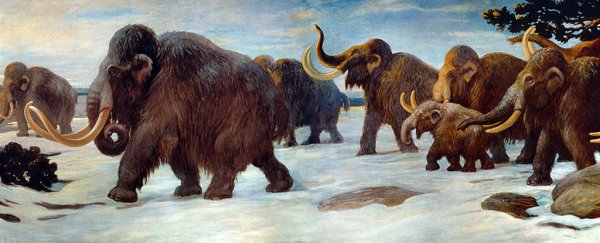A little over 4,000 years ago, one of Earth's last surviving populations of woolly mammoths weathered freezing conditions on a small island north of Siberia – and as their time on this planet came to an end, things looked grim for this once-tremendous species.
New research has shown that woolly mammoths (Mammuthus primigenius) spiralled into a "genomic meltdown" as their numbers dwindled, with detrimental mutations piling up and accelerating the mammoth's journey into extinction.
"It's sort of like a Greek tragedy that's written into the DNA of the poor mammoth," evolutionary geneticist Rebekah Rogers from the University of North Carolina at Charlotte told Live Science.
"You look at this mammoth's DNA and you see all these bad mutations."
To track the species' health from when the animals thrived to their poorly state prior to extinction, Rogers and biologist Monty Slatkin from UC Berkeley compared existing genomes from two woolly mammoths that lived more than 40,000 years apart.
Woolly mammoths once spread from northern Europe through Russia to North America – including Beringia, the land mass that once lay in between Russia and Canada.
On the mainlands, the species went extinct about 10,000 years back, but small populations survived in isolation on islands until around 3,700 years ago.
One of these locations was Wrangel Island, situated in the Arctic Ocean off the north Siberian coast.
On this island, a woolly mammoth once lived about 4,300 years ago in a small population of about 300 animals. Previous research had published the genome sequence of this specimen, along with that of another woolly mammoth that lived much earlier on the Siberian mainland, about 45,000 years ago.
While the Wrangel Island mammoth lived in a dwindling population, the mainland specimen belonged to a robust community some 43 times larger.
When the researchers compared the genetics of both specimens, they found that the Wrangel Island mammoth's population had saddled it with a number of harmful genes not present in the mainland specimen.
"In this island mammoth there is an excess of what look like bad mutations right before the mammoths go extinct," Rogers told Nicola Davis at The Guardian.
"We don't know exactly what happened, but this certainly did not help them out."
Amongst the mutations, the team found evidence that the Wrangel Island mammoth had lost many olfactory receptors, making it harder for the animal to smell and detect odours such as pheromones, which would have affected mate choice and social status.
In addition, mutations to a gene called FOXQ1 could have affected the structure of the woolly mammoth's thick coat of hair, leading it to take on a finer, satin-based appearance and structure.
In the freezing polar conditions at Wrangel Island, this thinner hair would have trapped less heat and made it harder for the animals to weather the chill, and the mutation may have caused other problems too.
"A lot of satin mutants are known to have digestive problems," Rogers told The Guardian, "and so it may have had heartburn, it may have had trouble digesting its food."
The findings don't necessarily mean that the smaller population had to resort to in-breeding – just that animal numbers may have dwindled to the point where there weren't enough good genes and variants to go around.
"What did happen was that the population was simply small," Rogers told Brian Switek at Nature.
"Bad mutations that would normally be weeded out weren't removed from the population because of reduced competition."
While the study provides a bleak picture of the last surviving woolly mammoths, the silver lining could be that it teaches us more about how genomic meltdowns can happen in small animal populations – thereby helping conservation efforts in the future.
"By the end, the Wrangel Island mammoths were genetically screwed," paleogenomics researcher Beth Shapiro at UC Santa Cruz, who wasn't involved with the study, told Science.
"Understanding how that happened might help us figure out which species today are most at risk of the same thing happening."
The findings are reported in PLOS Genetics.
